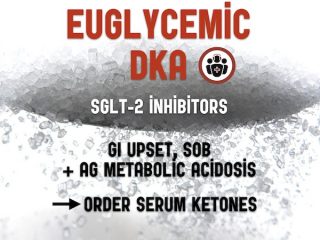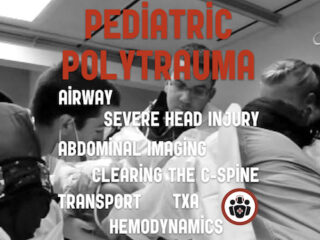Most Recent
Episode 97 EM Literature Review 2016 from EMU & Whistler Conferences
Quick and insightful reviews of 17 important adult and pediatric emergency medicine studies from 2016: The PROCAMIO study for stable VT, platelets for head bleeds (PATCH), BP lowering in ICH (ATACH II), antibiotics for abscesses, work up of subarachnoid hemorrhage, dosing IV ketorolac, the PESIT trial, ketamine dosage for sedation in pediatrics, instructions after minor head injury, Salter-Harris I fractures of the lateral malleolus, interpreting oxygen saturation for disposition making in children with bronchiolitis, clinical pathways in pediatric asthma and sepsis and more...
Best Case Ever 58 Euglycemic DKA
It's not only run of the mill DKA, starvation and alcoholic ketoacidosis that can cause a metabolic acidosis with elevated ketones. Euglycemic DKA can be caused by the newer diabetes medications sodium-glucose co-transporter 2 inhibitors like Canagliflozin; and it's important to recognize this tricky diagnosis early and initiate treatment for DKA despite a normal serum glucose level...
Episode 96 Beyond ACLS Cardiac Arrest – Live from EMU Conference 2017
This is the first ever video podcast on EM Cases with Jordan Chenkin from EMU Conference 2017 discussing how to optimize three aspects of cardiac arrest care: persistent ventricular fibrillation, optimizing pulse checks and PEA arrest, with code team videos contrasting the ACLS approach to an optimized approach...
Episode 95 Pediatric Trauma
Management of the pediatric trauma patient is challenging regardless of where you work. In this EM Cases episode, with the help of two leading pediatric trauma experts, Dr. Sue Beno from Hospital for Sick Children in Toronto and Dr. Faud Alnaji from Children's Hospital of Eastern Ontario in Ottawa we answer such questions as: what are the most important physiologic and anatomic differences between children and adults that are key to managing the trauma patient? How much fluid should be given prior to blood products? What is the role of POCUS in abdominal trauma? Which patients require abdominal CT? How do you clear the pediatric c-spine? Are atropine and fentanyl recommended as pre-induction agents in the pediatric trauma patient? How can the BIG score help us prognosticate? Is tranexamic acid recommended in early pediatric trauma like it is in adults? Is the Pediatric Trauma Score helpful in deciding which patients should be transferred to a trauma center? and many more...
Best Case Ever 57 PREPARE mnemonic for Airway Management
Airway management requires a lot things; it requires not only technical skills and specific considerations of anatomy and physiology but a co-ordinated team who can communicate clearly and react to a whole slew of potentially challenging situations. On this month's Best Case Ever podcast we use the framework of a new mnemonic PREPARE to discuss human factors, situational awareness and some airway tips and tricks with intensivist Peter Brindley, human factors expert Chris Hicks and EM-intensivist Sara Gray...
Episode 94 UTI Myths and Misconceptions
In 2014, the CDC reported that UTI antibiotic treatment was avoidable at least 39% of the time. Why? Over-diagnosis and treatment results from the fact that asymptomatic bacteriuria is very common in all age groups, urine cultures are frequently ordered without an appropriate indication, and urinalysis results are often misinterpreted. Think of the last time you prescribed antibiotics to a patient for suspected UTI – what convinced you that they had a UTI? Was it their story? Their exam? Or was it the urine dip results the nurse handed to you before you saw them? Does a patient’s indwelling catheter distort the urinalysis? How many WBCs/hpf is enough WBCs to call it a UTI? Can culture results be trusted if there are epithelial cells in the specimen? Can a “dirty” urine in an obtunded elderly patient help guide management?...







